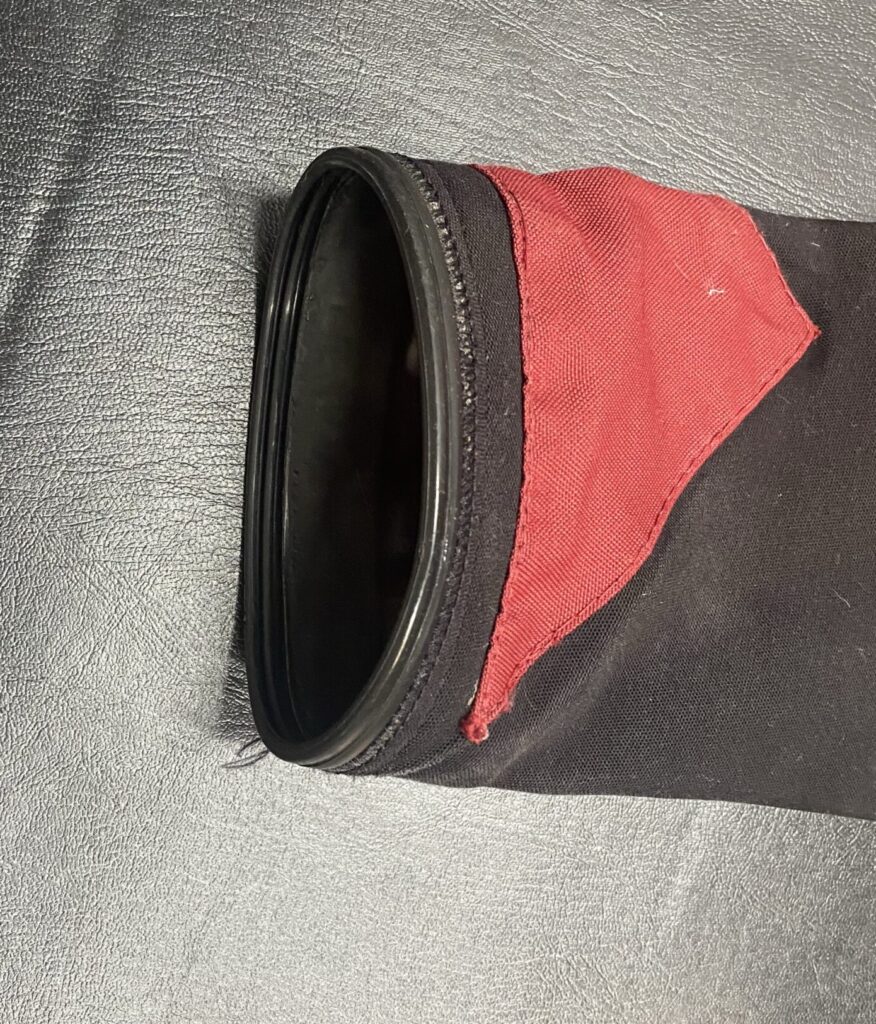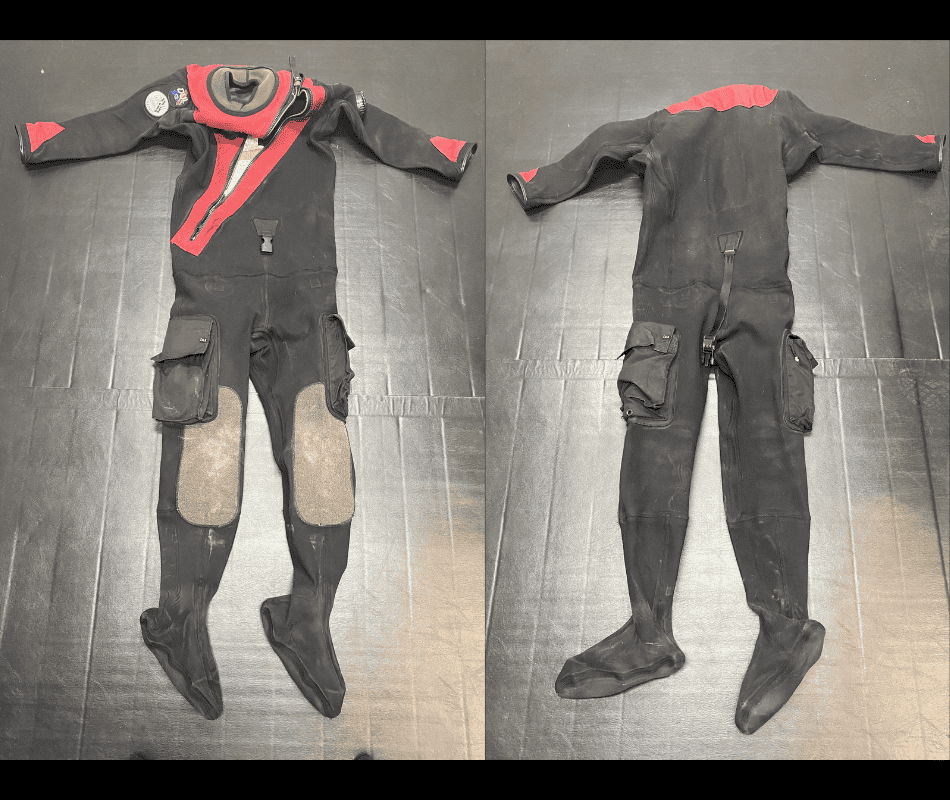If you are looking for a durable and, dare I say it, almost indestructible dry suit with some thermal properties, then the DUI CF 200 is the suit for you.
Key Features
-Durability
-Flexibility
-Thermal protection
Let’s take a look at the DUI CF 200 crushed neoprene drysuit. In particular, we will examine the suit I have been diving in since 2010: a 2001 signature series CF 200 with a Maroon Nylon shell.
How I got the suit
I bought this as a used suit I found on eBay in 2010. The previous owner said the dry suit was custom-built in 2001 and had well over 400 dives, but it hasn’t been dove in several years. After speaking to several friends who either owned CF 200s or had experience with them, they explained that the suit would still have a lot of life in it even with over 400 dives, so I took the chance and bought the suit.
The person selling it was in California, USA, and I am in Ontario, Canada. We arranged that if the suit didn’t fit me the way I liked, they would happily refund me, less the shipping cost, which I thought was very fair.
Once I got the suit, it fit perfectly, almost on the verge of being Cave Cut ( a custom size cave divers like with the least amount of extra room in the suit to reduce any bagginess). I kept the suit and have had it ever since 2010 and have put at least another 300 dives on it.
Fit and Feel
The Cf 200 was very form-fitting; having the front entry zipper made it relatively easy to get in and out of the suit. The crushed neoprene has some natural stretch, which is nice when pulling it on, allowing you a little forgiveness when putting it on with a thick undergarment.
If you lose balance while putting it on and happen to stretch the suit awkwardly, it is not likely to tear easily. This CF 200 crushed neoprene provided supremely natural movement when on, along with the telescoping torose. The CF 200 allows for full ranges of motion and ease of reaching your pockets or tank valves when in the water.
Construction
The suit is 3 mm of neoprene crushed down to 1 mm; this makes for a very durable material. With the hundreds of dives on the suit, I have never had a puncture, and that is with dozens if not hundreds of shore dives where I am usually gearing up sitting on a rock or a metal boat when on a charter, and the neoprene has held up well.
At most, the areas that experience the most wear and tear show discolouration or fading in that area but do not look like it is thinning.
The suit also has a front entry zipper that I have replaced once on the suit as it had a significant failure about 200 dives ago. That means the original zipper with regular maintenance (lubricating/zipper wax at the end of each dive) lasted about 600 dives.
The suit has only required some patching up on the seams as, over time, putting the suit on has worn away the glue on the seams, leading to pin holes that leak, but a little aqua seal and a tongue depressor over the seams and I was back to a fully dry dive.
1st Generation Zip seal

The suit had first-generation Zip seals on it. Zip seals are efficient; they enable the wrist and neck seals to be changed at any time without a service technician.
I have had suits with glued-in seals before, and I liked having the zip seal options over the glued-in seals. Being able to change a seal on the fly if one rips has substantial cost savings because you don’t have to send the suit in for service, costing money on shipping and labour along with lost dive time.
The first generations of Zip seals only work with the latex wrist and neck seal, which worked fine for me. I can’t comment on whether silicone seals are more durable or more comfortable as they will only work on the second-generation Zip seals, and I have no experience with them.
Rock Boots

The rocking boot provides a very sturdy and rugged footwear option for the suit. Because I do a lot of shore diving with very rocky entries, the rock boots have helped my suit hold up well. The rock boots show a lot of wear, but my suit’s neoprene socks are in excellent condition.
When I had my suit, my dive buddy had been diving a DUI trilaminate suit with turbo soles. We have a similar number of dives at that exact location. He had to send his suit in for service because his turbo soles started to unglue from the drysuit sock, and the toe area of the sock had no extra protection by the turbo souls, so a hole almost wore right through the top of the foot on the turbo soles.
This is an anecdotal example as it’s not my first-hand experience and may have to do with how my dive buddy cares for his suit, but the rock boots have held up, considering.
Suit usability
This suit had some great features like the durability and thermal protection that the crushed neoprene provides; because it is made of neoprene, it provides some insulation from cold water or at least noticeably more than a trilaminate suit.
Something I wasn’t aware of until I compared it to a trilaminate is the suit’s weight. Cf 200, when fully dry, weighs in at ( wight suit), which is something to consider if you plan on travelling with the suit. Another factor is the 2-4 days the suit requires to dry thoroughly, and the suit also weighs quite a bit when wet as the crushed neoprene absorbs some water.
The first time I travelled with the suit, I took it down to Florida Cave Country (Florida panhandle area) for five days for diving. When it came time to leave, I couldn’t believe that all my dive gear was almost 10lb heavier than when I had arrived.

After some investigating, I realized that all the water the dry suit had absorbed and crushed neoprene didn’t dry quickly. I had to pay for overweight baggage to fly home as there weren’t 3 to 4 days in my itinerary to wait for the suit to dry. I mention it here to save you grief and a little money, hopefully.
Conclusion
If you’re looking for a dry suit that is nearly indestructible and easy to repair, it has good thermal protection compared to most trilaminate dry suits. If you can get a suit as customized as you can imagine, you won’t regret going with a DUI CF200. The only downside that I can think of is that it is heavier than most dry suits and takes longer to dry. CF 200 by DUI will be the last dry suit you will ever buy. I think the only reason anyone would ever have to get rid of it is if you put on too much weight and it stops fitting you, and that’s not a negative against the dry suit.
